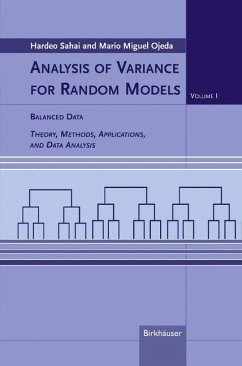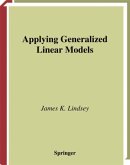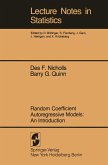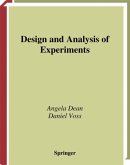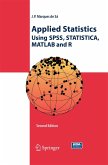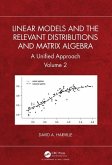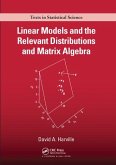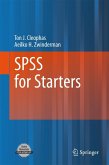ANOVA models involving random effects have found widespread application to experimental design in varied fields such as biology, econometrics, and engineering. Volume I of this two-part work is a comprehensive presentation of methods and techniques for point estimation, interval estimation, and hypotheses tests for linear models involving random effects. Volume I examines models with balanced data (orthogonal models); Volume II studies models with unbalanced data (non-orthogonal models).
Accessible to readers with a modest mathematical and statistical background, the work will appeal to a broad audience of graduate students, researchers, and practitioners. It can be used as a graduate text or as a self-study reference.
Accessible to readers with a modest mathematical and statistical background, the work will appeal to a broad audience of graduate students, researchers, and practitioners. It can be used as a graduate text or as a self-study reference.
"In general, the sections of each chapter cover the mathematical model, analysis of variance, point and interval estimation of variance components, hypothesis tests, and Bayesian estimation.... Each chapter includes plenty of examples, most of which contain hand calculations. There are also numerous examples of software output, including SAS, SPSS, and BMDP output....
The layout of this comprehensive book makes it easy to find exactly what you need. The writing is clear, giving extensive explanations of advanced topics. The authors make it clear in the Preface that they are providing comprehensive coverage of linear models with random effects. They do not, in general, provide proofs of theorems.... However, plenty of references are given for the reader who wishes to delve into the theory more deeply....
In short, this book is an excellent addition to my modeling library. Volume II on unbalanced models has been published and looks to be as good a book as Volume I." -TECHNOMETRICS
"This is Volume I, covering balanced data, of a two-volume work on the analysis of variance used to develop random effects models. The theory and practice of fitting models, where all effects are considered to be random, are discussed in considerable detail for a wide range of experimental situations involving one, two or three factors, including both crossed and nested designs.... Within each chapter for each model, the distribution theory of a variety of classical estimators...is described, and these estimators are illustrated with a numerical example supported by computer output derived from SAS, SPSS and BMDP.... This text will provide a useful reference source for theoretical results and practical examples since each chapter is further supported by a comprehensive set of exercises and an extensive reference list." -Short Book Reviews of the International Statistical Institute
"This book is accessible to readerswith only a modest mathematical and statistical background. The work will appeal to a broad audience of students, researchers, and practitioners in the mathematical, life, social, and engineering sciences. It may be used as a textbook in upper-level undergraduate and graduate courses, or as a reference for readers interested in the use of random effects models for data analysis." -Zentralblatt Math
Review of both volumes
"This two-volume set provides an encyclopedic and historical account of the theory and application of classical random-effects models.... For users of random-effects models and those interested in the theoretical development of this topic, these books are a valuable resource.... Throuhgout the [text], the authors go to great lengths to provide references to original sources that would allow the reader to fill in details that are not included in the text.... By selecting an appropriate subset of topics, an instructor could create an outstanding graduate-level course on random-effects models.... These books provide an excellent unified reference on the methodological developments associated with classical random-effects models over the past 50 years." -Journal of the American Statistical Association
The layout of this comprehensive book makes it easy to find exactly what you need. The writing is clear, giving extensive explanations of advanced topics. The authors make it clear in the Preface that they are providing comprehensive coverage of linear models with random effects. They do not, in general, provide proofs of theorems.... However, plenty of references are given for the reader who wishes to delve into the theory more deeply....
In short, this book is an excellent addition to my modeling library. Volume II on unbalanced models has been published and looks to be as good a book as Volume I." -TECHNOMETRICS
"This is Volume I, covering balanced data, of a two-volume work on the analysis of variance used to develop random effects models. The theory and practice of fitting models, where all effects are considered to be random, are discussed in considerable detail for a wide range of experimental situations involving one, two or three factors, including both crossed and nested designs.... Within each chapter for each model, the distribution theory of a variety of classical estimators...is described, and these estimators are illustrated with a numerical example supported by computer output derived from SAS, SPSS and BMDP.... This text will provide a useful reference source for theoretical results and practical examples since each chapter is further supported by a comprehensive set of exercises and an extensive reference list." -Short Book Reviews of the International Statistical Institute
"This book is accessible to readerswith only a modest mathematical and statistical background. The work will appeal to a broad audience of students, researchers, and practitioners in the mathematical, life, social, and engineering sciences. It may be used as a textbook in upper-level undergraduate and graduate courses, or as a reference for readers interested in the use of random effects models for data analysis." -Zentralblatt Math
Review of both volumes
"This two-volume set provides an encyclopedic and historical account of the theory and application of classical random-effects models.... For users of random-effects models and those interested in the theoretical development of this topic, these books are a valuable resource.... Throuhgout the [text], the authors go to great lengths to provide references to original sources that would allow the reader to fill in details that are not included in the text.... By selecting an appropriate subset of topics, an instructor could create an outstanding graduate-level course on random-effects models.... These books provide an excellent unified reference on the methodological developments associated with classical random-effects models over the past 50 years." -Journal of the American Statistical Association
From the reviews:
"This is the second of a two-volume comprehensive review of the analysis of variance for random effects models. Volume I was devoted to various models using balanced data, whereas this volume is concerned with unbalanced data. The book provides extensive coverage of the methods and techniques of point estimation, interval estimation and tests of hypotheses for random effects models. A variety of experimental designs are considered involving one, two, three and multi-factor experiments with crossed and nested factors. Throughout the text, the procedures are illustrated using numerical examples analyzed with several software systems.... The book will be particularly useful as a reference source to the literature of random effects models with each chapter having its own bibliography and with the main extensive reference section containing more than six hundred papers." -- Short Book Reviews of the International Statistical Institute
"The book presents the theory, methods, data analysis, and applications requiring measurements of variance from several fields as agriculture, biology, applied genetics, animal breeding, medicine as well as eco-social sciences, including econometrics, quality control, and engineering. Numerical examples are given to analyse data and illustrate the theory and methods.... This monograph is an excellent book giving a survey of major theoretical and methodological developments for scientific research and application-oriented scientists." -- Zentralblatt Math
Review of both volumes
"This two-volume set provides an encyclopedic and historical account of the theory and application of classical random-effects models.... For users of random-effects models and those interested in the theoretical development of this topic, these books are a valuable resource.... Throuhgout the [text], the authors go to great lengths to provide references to original sources that would allow the reader to fill in details that are not included in the text.... By selecting an appropriate subset of topics, an instructor could create an outstanding graduate-level course on random-effects models.... These books provide an excellent unified reference on the methodological developments associated with classical random-effects models over the past 50 years." -- Journal of the American Statistical Association
"This is the second volume of a two-volume monograph on analysis of variance for random and mixed linear models. ... This book presents a systematic and comprehensive coverage of different methods and techniques, mainly of point estimations ... . At the end of each chapter there is a wide variety of well-chosen exercises ... . Each chapter ends with a complete bibliography for the references in that chapter. The book ... is well written." (Jon Stene, Mathematical Reviews, Issue 2006 i)
"This is the second of a two-volume comprehensive review of the analysis of variance for random effects models. Volume I was devoted to various models using balanced data, whereas this volume is concerned with unbalanced data. The book provides extensive coverage of the methods and techniques of point estimation, interval estimation and tests of hypotheses for random effects models. A variety of experimental designs are considered involving one, two, three and multi-factor experiments with crossed and nested factors. Throughout the text, the procedures are illustrated using numerical examples analyzed with several software systems.... The book will be particularly useful as a reference source to the literature of random effects models with each chapter having its own bibliography and with the main extensive reference section containing more than six hundred papers." -- Short Book Reviews of the International Statistical Institute
"The book presents the theory, methods, data analysis, and applications requiring measurements of variance from several fields as agriculture, biology, applied genetics, animal breeding, medicine as well as eco-social sciences, including econometrics, quality control, and engineering. Numerical examples are given to analyse data and illustrate the theory and methods.... This monograph is an excellent book giving a survey of major theoretical and methodological developments for scientific research and application-oriented scientists." -- Zentralblatt Math
Review of both volumes
"This two-volume set provides an encyclopedic and historical account of the theory and application of classical random-effects models.... For users of random-effects models and those interested in the theoretical development of this topic, these books are a valuable resource.... Throuhgout the [text], the authors go to great lengths to provide references to original sources that would allow the reader to fill in details that are not included in the text.... By selecting an appropriate subset of topics, an instructor could create an outstanding graduate-level course on random-effects models.... These books provide an excellent unified reference on the methodological developments associated with classical random-effects models over the past 50 years." -- Journal of the American Statistical Association
"This is the second volume of a two-volume monograph on analysis of variance for random and mixed linear models. ... This book presents a systematic and comprehensive coverage of different methods and techniques, mainly of point estimations ... . At the end of each chapter there is a wide variety of well-chosen exercises ... . Each chapter ends with a complete bibliography for the references in that chapter. The book ... is well written." (Jon Stene, Mathematical Reviews, Issue 2006 i)

